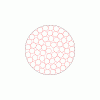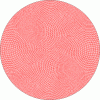I find it odd that the transformer equation doesn't include current...because I just picked a core of a physical size that I deemed reasonable to have eight of and punched it's cross section in with 8 turns (just enough to be fairly evenly distributed along the toroid) and it's only giving me 710 Gauss with my voltage and frequency requirements (and the equation doesn't ask for current). The core material itself is supposed to be able to handle 8000Gauss-10000Gauss. So either my tolerable physical size is way larger than is magnetically required, or I'm doing something wrong.
I keep seeing the word "window" brought up though and as best as I can tell, it's just the size of the hole in the toroid core? But I'm sure it must have some other more relevent magnetic definition since not all inductors or transformers are toroidal. But everything on Google seems to refer to it as a given, without explaining what it actually is.
Speaking of litz wire, this does't seem that bad:
**broken link removed**
Not entirely sure if it's accurate to figure out the current rating by simply going 13 strands * Current capacity for 30AWG (taking skin effect into account at the frequency of interest). Seems there would be lots of derating since its like bundling wires as well as winding them together. They all seem pretty low current though.
I keep seeing the word "window" brought up though and as best as I can tell, it's just the size of the hole in the toroid core? But I'm sure it must have some other more relevent magnetic definition since not all inductors or transformers are toroidal. But everything on Google seems to refer to it as a given, without explaining what it actually is.
Speaking of litz wire, this does't seem that bad:
**broken link removed**
Not entirely sure if it's accurate to figure out the current rating by simply going 13 strands * Current capacity for 30AWG (taking skin effect into account at the frequency of interest). Seems there would be lots of derating since its like bundling wires as well as winding them together. They all seem pretty low current though.
Last edited:



